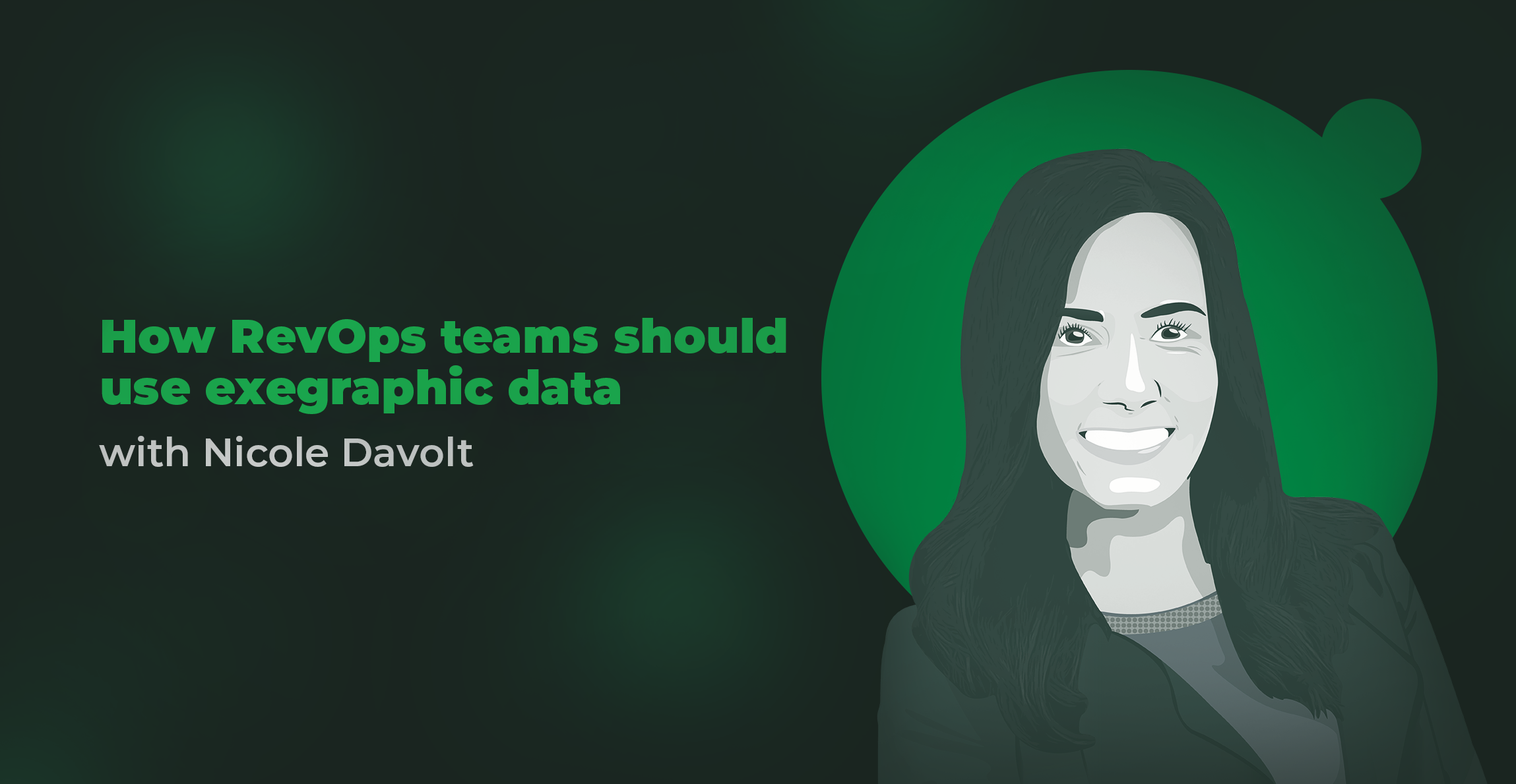RevOps teams are under enormous pressure to grow their companies, and to grow them efficiently. Even C-suites are feeling this pressure. When they do, they turn to Nicole Davolt, a RevOps strategist at Intelligent Demand.
“We align their tactics, their technology and their people into a strategic growth strategy and a program that allows them to acquire, retain and expand revenue with their best-fitting customers and prospects,” Nicole says. “But really, we just exist to help tame the complexity of modern B2B growth.”
An expert growth partner helps companies and RevOps teams align Sales and Marketing (and others within an organization) to deliver better overall customer experience, as well as improve the prioritization of operations within the sales pipeline.
To that end, we dove into conversation with Nicole about exegraphic data—how it functions, how it changes the way revenue teams can think about targeting accounts, and how it can improve precision, streamline operations, maximize resources and harmonize often competing teams within your organization.
Exegraphics: The behavioral traits of companies
Before companies can improve the precision of their targeting with exegraphics, it helps to understand how exegraphics work.
“I like to think of them as psychographic traits for B2C, but now for B2B,” Nicole says. “Instead of those psychographic traits about an individual, exegraphics are traits about the business and how a business behaves.”
Whereas more traditional firmographics include traits such as industry, size, and revenue, exegraphics examine hundreds of other, more behavioral, traits like: Are companies early adopters of technology? Are they hiring a larger sales team? Are they expanding their marketing teams? How do they operate on the inside and on the outside?
“Exegraphics let us get a more complete picture and a more holistic view of an account,” Nicole says. “When you look at just firmographics, you might have tens or hundreds of thousands of accounts that fit that profile. When you’re conducting an account-based campaign, you need to narrow those down to who will fit your ICP best and who acts just like your best customers—the ones that you would want to clone out hundreds of times if you could.”
Whereas doing this “by hand” would be practically impossible, the AI-driven model behind exegraphics assesses hundreds of aspects to build out an image of what makes those customers the best—and identifies (and ranks) others that resemble them.
Nicole points out that the answer in identifying top prospects does not lie in plucking single exegraphic threads; it’s the composite pattern-matching that creates a more meaningful customer profile than humans could reasonably accomplish alone.
In short: “Exegraphics give us more confidence in building our ICP,” she says.
Prioritizing accounts to get to market faster
Building a quality ICP is an early step—not an end goal. For Nicole, the real power of exegraphics comes into play for prioritizing all those accounts that match your ICP.
“Clients understand generally what their ideal client looks like,” she says, “but they don’t know which ones to go after, how to go after them and who to pay special attention to.”
As an example, Intelligent Demand had a client with a target account list upward of 65,000 accounts—and they lacked the resources to tackle that entire list. So the agency assessed the client’s best customers with Rev’s AI-powered Sales Development Platform and compared them to the prospect list, in order to whittle it to something not only more manageable but more impactful.
Exegraphics trimmed that list to about 10,000 accounts—and then Nicole used them to help rank the remaining candidates.
Then, “Do we want to spread your budget evenly like peanut butter across all these accounts?” she asked. “Or are there certain accounts we want to pay more special attention to? Who do we prioritize for a specialized one-to-one outreach, one-to-few, and one-to-many? Let’s look at how closely they correlate to your best customers.”
Exegraphics (in combination with intent and campaign engagement data) identified the 200 accounts best matched to the ICP, with the highest likelihood to engage.
As Nicole puts it: “Exegraphics enabled us to get to market faster and be able to make smarter decisions at the beginning of the campaign, when we had limited amounts of data.”
Three data sets playing together: exegraphics, intent and campaign engagement
Nicole referenced intent and campaign engagement data above, and that they play well with exegraphic data to prioritize accounts. Here’s how she explains them as distinct approaches to understanding prospects:
- Exegraphics are like the personality traits of an account: more fixed, and slower to change. “My personality traits don’t change drastically in a short amount of time,” she says. “If an account is likely to be an early adopter of technology or is in a high growth mode, they’re likely to be in that same mode six months to a year from now.”
- Intent and campaign engagement data examines what an account is interested in. “What are they searching? Which kind of articles are they reading? What are they looking for? Are they in market for something that I have to sell right now?” These data sets are ever-changing.
When these data sets intersect, an ideal customer becomes an ideal customer right now (and thus a high priority for sales and marketing outreach).
Maximizing limited resources
A common theme in RevOps teams that Nicole works with is this: Teams struggle with limited resources. How can they use this exegraphic data to maximize the resources that they do have?
Nicole provides these three insights into prioritizing a team’s resources in addition to prioritizing their prospects:
- Get discovery out of the way. “Sales teams don’t have to get on a phone call to uncover the things that you can’t normally see,” she says. “We’re able to see them through exegraphics.” For instance, Intelligent Demand generally looks for clients with a certain level of marketing maturity—and exegraphics helps the Sales team assess the marketing maturity of an account directionally before even reaching out.
- Determine your talk track. We all know that prospects have different personas that we talk to throughout the sales cycle, and many organizations have standard talk tracks for them. But how to know which ones to lead with? Exegraphics enable a team to step into conversations with high confidence that they’re using the most applicable talk track because they already understand certain behaviors (and thus certain pain points) within the organization.
- Align Sales and Marketing. The process of using exegraphics to select accounts can actually bring Sales and Marketing teams together. “Historically, you have Marketing teams pick certain accounts for certain reasons, and Sales teams pick certain accounts for certain reasons,” Nicole says. Exegraphics help both teams hone those lists in tandem, without it being a matter of stepping on each other’s domains—instead, Sales and Marketing alignment becomes about identifying the accounts most likely to succeed with limited resources to target them. “It opens up the conversation and gives teams data points to be confident in the accounts they’re selecting, as well,” she says.
Final thoughts: Creating harmonious RevOps teams
Each step of Nicole’s exegraphic discussion comes back to prioritization:
- Identifying what traits matter most to your ICP
- Choosing the accounts most likely to purchase
- Selecting other relevant data points
- Maximizing limited resources
Exegraphic prioritization enables more than just a smoother, more efficient pipeline, though. It also creates more internal harmony within RevOps.
“When we’re aligned on a target account list, especially for an account-based campaign or an account-based play, there’s less handoff between Marketing and Sales,” Nicole says. “There’s more of What are we going to do at the same time, together? What activities are we going to do at each point in the customer life cycle to work together to get them to the next phase?”
While Marketing and Sales may each take the lead at various points, exegraphic data-driven foundation aligns them on a continuous, parallel path—for the good of your RevOps team as well as your customers.
Interested in hearing the full conversation with Nicole Davolt? Watch it here.


